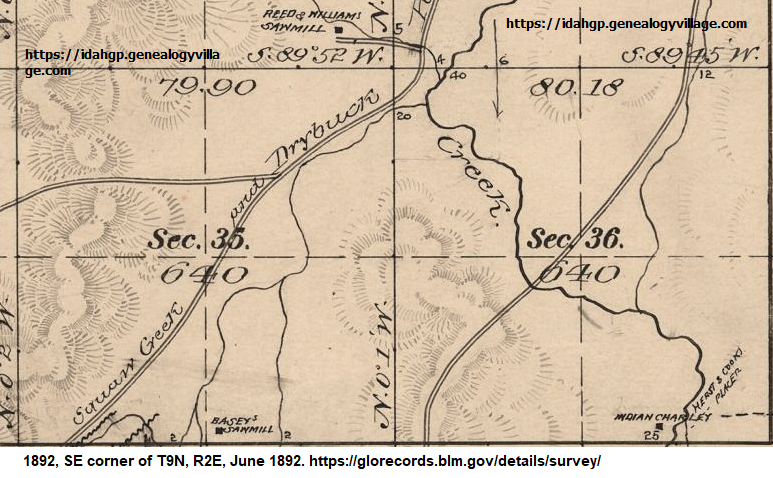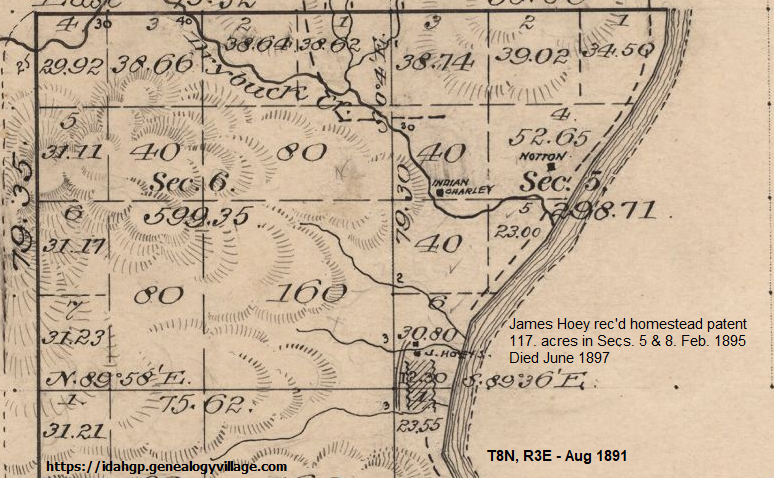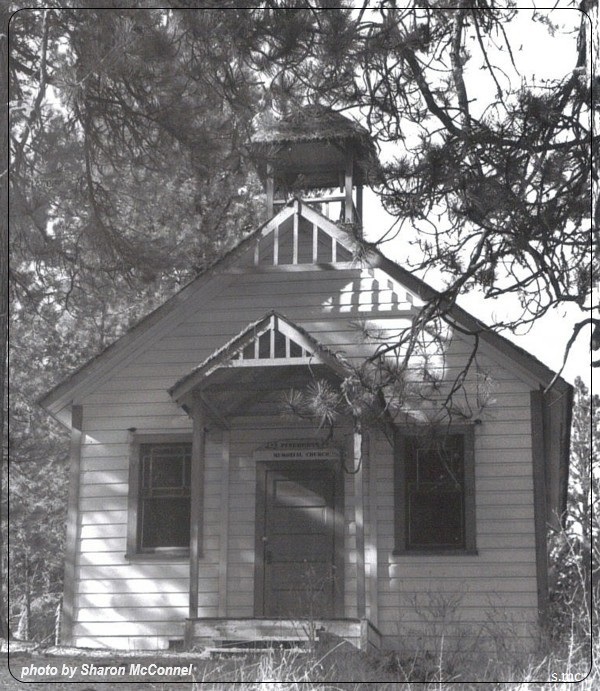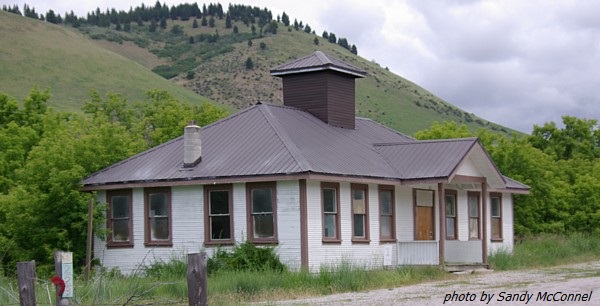The Brownlee Trail
"The expected rush to Boise Basin in the fall of 1862 materialized, and the camps of Pioneer, Centerville, Placerville, Buena Vista, and Bannock City (later Idaho City) were established. Thousands of miners, packers, gamblers, and merchants begain to arrive, following the route which came in from the west. This main route was the old Indian trail 'used by the Umatillas and other Indians of Oregon' to reach the council grounds on the Weiser River. Known to whites as the Brownlee Trail, it came down out of Oregon through the hills of the Grande Ronde Valley and crossed the Snake River at the Brownlee Ferry, following the road blazed by the Goodale train the year before. After passing through the southern boundary of the Weiser country, it followed the Payette River as far as Horseshoe Bend before heading up Harris Creek into the Boise Basin." - (p. 35) Hank Corless, "The Weiser Indians/Shoshoni Peacemakers." Caxton Printers, Caldwell, Idaho, 1996.
"Goodale North" Oregon Trail Variant in depth
Nellie Ireton Mills writes - "Indians, trappers and prospectors followed the eastern extenstion of this trail from the Weiser River up Crane Creek, thence over a pass in the hills to Squaw Creek, about fifteen miles above present Ola. From Ola it crossed Little Squaw Creek, followed up Soldier Creek, then over Timbered Butte to Brownlee Creek and down to the ford on the Payette, a few miles above Horseshoe Bend. On the Soldier Creek side of Timbered Butte, the Indians had a natural ammunition depository - a ledge of flint perfect for arrows - probably one reason for the trail passing that way." (p. 32) Nellie Ireton Mills, "All Along the River." Payette Radio Limited, Montreal, Canada.
The Early Wagon Road, about 1882
"The early wagon road into Long Valley was via Squaw Creek, Sweet, and Brownlee, over Dry Buck Summit into High Valley, and on to Smith's Ferry, Round Valley, and Clear Creek. The road and ferry were built about 1882, when the need for ties for construction of the Oregon Short Line initiated the first export of logging products from the upper Payette River. Before the Oregon Short Line built the Idaho Northern Branch railway to McCall (opened in 1915), a four-horse-team stagecoach was operated between Emmett and Van Wyck, carrying passengers, mail, and supplies." - "History of Boise National Forest 1905-1976"
Dry Buck Valley and Dry Buck Creek
Reed's Sawmill, Dry Buck, and Reed Bros. Logging Crew
Original GLO survey showing the location of the Reed & Williams Sawmill and Basey's Sawmill as well as Indian Charley's place -


Following Dry Buck Creek southeast downstream two or three miles to the Payette River and James Hoey's homestead, which Mills calls the "Indian Camp. - "At an early date, Jimmy Hoy1, an Irish trapper, and a friend built cabins on the west side of the river on a flat at the mouth of Dry Buck Creek, about a mile below the confluence of the north and south forks of the Payette. Here they were soon joined by a band of abouth thirty Indians. They had been banished from the Lemhi tribe for some tribal offense, after Old Charley, their leader, and his son each had an eye put out in punishment, and had wandered through the hills until they found this haven." Corless writes: "Indian Charley, a Nez Perce member of the Weiser group, should not be confused with Eagle Eye2, who is a Shoshoni and an entirely seperate individual, though it is thought they were related by marriage - 'Idaho Statesman,' April 5, 1898."
Pinehurst Church at Dry Buck

In western Boise County, on Dry Buck - the road forks a little north of here, with the north road going into High Valley (Valley County) and the east road going down to Banks, on the Payette River. The old school was northeast of the junction. The community of Brownlee is to the south, at another fork in the road -- with the west branch going to Sweet, Gem County, and the east branch going to Gardena. This would have been on the route into Thunder Mountain, Valley County. There was a post office in this area from 1903 to 1918. At least once postmistress, Ursula Moore, carried a few groceries. There were early-day sawmills in the area.
1915 Polk's Directory for Pinehurst.
1955, 20th Anniversary of dedication of church
Brownlee School

Photo by Sandy McConnel
Added to the Historical Register in 1998, the Upper Brownlee School, also known as Brownlee Community Clubhouse, is on the Dry Buck Road, 0.1 NE of junction of Timber Butte Rd. and Dry Buck Road, Sweet.
Thanks for sharing, Sandy!
Notes
1The Emmett Index, June 25, 1897: "Dr. Lutz received a call last Friday evening to go to the mouth Dry Buck creek on the North Fork of the Payette to visit James Hoy who was very sick at his cabin at that place. The doctor made the trip in the night and returned next day. He found the old man in a critical condition suffering from inflammatory rheumatism and dropsy and so far gone that medical skill could be of but little avail.
" —James Hoy, an old mountaineer who has lived for years among the Indians on Dry Buck creek in Boise county died on Sunday the 20 inst."
- The Emmett index, June 25, 1897
"Jimmy Hoye" is buried in the Sweet cemetery. The notes from that entry are as follows:
Obituary for James Hoey (1834-1897) says that he was buried in Sweet. It has also been speculated that this is the grave of his son, Jimmy Hoey Jr. who was reportedly killed in Horseshoe Bend bar fight, date unknown. (Mills, p. 226). Researcher David Humpherys has found an August 4, 1913 Idaho Statesman article reporting a "shooting scrape" in the Horseshoe Bend where Billy Hoye pulls a pistol in a card game and is shot by Charlie Sells but is not seriously wounded. Billy Hoey (an Indian, b. 17 January 1890, Dry Buck) registered for the draft in Custer County, Jimmy Hoey did not. Billy Hoey was killed in Custer County in 1940; the story of his trial can be found at "Recorder Herald," The Salmon Public Library.
2Eagle Eye of the Northern Shoshone ~Eagle Eye, Last Chief of the Tukudia. ~ Tukudika, Indians of the Wilderness ~ 1896, June - Eagle Eye Dies
Updated May 2, 2021

Webspace for this site is generously provided by Genealogy Village and Access Genealogy
Copyright © 2013 - Sharon McConnel. All Rights Reserved.
